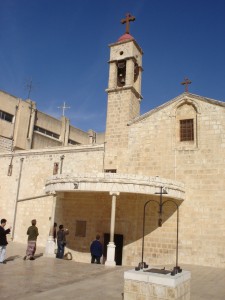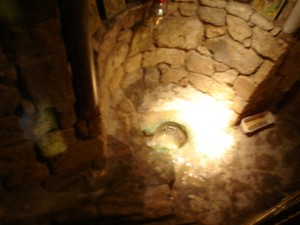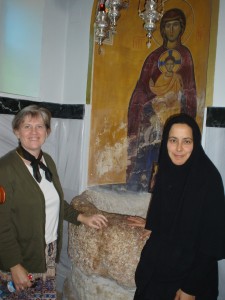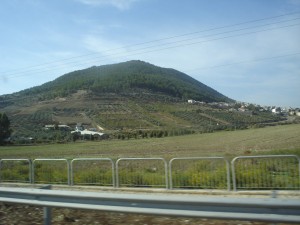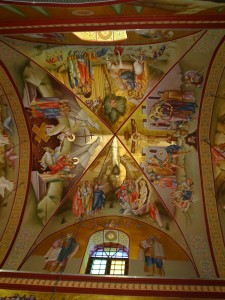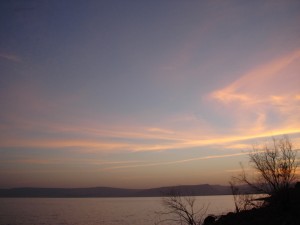The Accidental Pilgrim, Part 1: Nazareth, Cana, Mt. Tabor, Capernaum
November 2005
Hello from Jerusalem,
We were thrilled when they offered to take us to Galilee. It was absurd that we’d been in Israel for over a year and hadn’t yet made or found the time to drive the mere two hours to the area around the Sea of Galilee with its many Christian sites, beautiful rolling hills, and pastoral landscape. Now with two cousins and a cousin-in-law as house guests, we were finally making plans to go there, led by two Orthodox nuns from the monastery where we go to church. Mother Katherine, an American about our age, and Sister Ambrosia, an English speaking Russian in her 30s, are fun, energetic and faithful people and we were glad to be guided by them.
The two nuns pulled up in their large van promptly at 8:00 a.m. the morning after Thanksgiving (along with the Abbess and other friends, they had celebrated Thanksgiving with us the night before). Two hours later we parked in Nazareth at the church built over and around the well where Mary was told by Gabriel that she would give birth to Jesus. The smallish church has an Orthodox looking sanctuary with a set of stairs off the side leading to a dimly lit area where you could look down and see the spring. A spigot drawing from the spring allowed visitors to fill bottles with the water
Mother Katherine brought a book with brief descriptions of the holy sites, a passage of Scripture describing what took place there, and a brief prayer. I was still in tourist mode, enjoying the antiquity and the feel of the place when she handed me the book and asked me to read. No problem, I thought. I was caught by surprise not to be able to make it through even a few sentences without choking up. I had to ask her to finish reading. What was that all about?
From there we walked to a modern Catholic basilica built over the historic site of Joseph’s house and shop. This structure was as disappointing as the first church was quaint and holy. The massive church’s colors, concrete and steel, attempted to be beautiful-modern but only looked industrial-ugly to me. In fact, Nazareth itself is mostly a largish, Israeli-Arab city with lots of traffic and people and shops: not a place to imagine a carpenter’s son helping his father in the workshop or playing in the hills with his friends.
Next stop was Cana, site of the wedding feast at which Jesus turned water into wine. Surrounded by citrus trees and grape vines, this cute white church was tidy, like a well pruned rose bush. In the front of the sanctuary were two large stone jars believed to be some of the jars filled with the wine Jesus changed from water. The heavy, waist-high stone vessels once held a lot of liquid. According to Church tradition the groom at the wedding was Simon the Zealot who later became one of Jesus’ disciples. Soon, a woman came out to sell candles and bottles of wine. The wine labels said Cana-in-Galilee and had an icon of Christ at the wedding feast. We bought a few to help support and maintain the church. Our Cana wine, which undoubtedly had once been water, had been changed to wine by the God-given process of fermentation, good enough for me.
From there we drove to one of the more spectacular sites on our trip, Mt. Tabor. This is the site where Jesus was transfigured. Tabor is as much a mountain as the Sea of Galilee is a sea, but to say hill or lake robs a bit of the grandeur which both have in spite of their names. I wonder if that’s a good image for so much in the Holy Land. Many things here seem small or insignificant, but as I stand in their presence they loom large. This is definitely true of Mt. Tabor and the Sea of Galilee.
Mt. Tabor stands alone, an isolated, high, mounded hill you can see from miles away. A small Arab community, through which you must drive to find the narrow, snaking, barely two lane road wending its way to the top, nestles at its base. At the peak are two churches, one Orthodox, the other Catholic. The Catholic one is built on the ruins of an ancient church and is surrounded by the ruins of an ancient monastery. Nearby, the Orthodox church and monastery are behind a high wall and tall gate. Thankfully we were with two nuns who helped us get in. (When I returned during Christmas holidays with our three children, we knocked for awhile until a nun came to the door. After a bit of an interview, she determined that we were real pilgrims and not just gawking tourists. It was like we were undercover agents identifying ourselves at a remote base, possibly another apt image.) The church itself is beautiful. The icons, which cover every inch of wall and ceiling, are wonderful, colorful, exquisite images of events from the life of Christ, and of saints. The hushed, holy feel of the place gave me comfort.
Upon leaving Tabor, we drove directly to Tiberias, first built by the Romans on the shores of Galilee during Jesus’ life, today a hotel and restaurant filled sea-side resort town. From Tiberias we turned left and headed north on a curving road along the water’s edge to Capernaum, to a monastery where we would spend the night. The monastery is managed by one Greek monk, Fr. Irinarchos, an energetic, smart, holy man, probably about 40 years old. He single-handedly keeps up the grounds and church at the site of ancient Capernaum, the city Jesus used as a base during his ministry. There is nothing left of Capernaum now except for some archaeological sites. Standing on the shore of Galilee, looking at the contours of the surrounding hills, seeing birds fly over the water, I realize this is probably much closer to what Jesus actually saw than Jerusalem which has been destroyed and rebuilt and expanded many times in the last 2,000 years.
We take our things to our rooms (one for the girls, one for the boys: ah, monastery life!), then watch the sun set behind the hills west of the Sea of Galilee. After supper in Tiberias, we returned to the monastery, weary pilgrims laying ourselves down to sleep, praying the Lord our souls to keep. As He will.
Next: The Accidental Pilgrim, part 2: Mount of Beatitudes, Jordan River A, Hippo, and Jordan River B.

